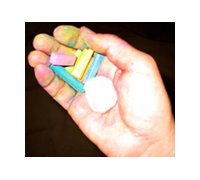Several people have asked about the steps I go though creating a drawing. I always work from photographs. This suits my work style, pace, and schedule, plus I am drawn to the flattening inherent in photos. I almost always use found images or stock photos, highly cropped almost to the point of abstraction. Then I tape the photo to the easel, clamp on a sheet of paper (usually Rives BFK or Crescent board) and do a quick charcoal or gray chalk sketch to roughly indicate shape and general placement of forms. At this point, I am not concerned with detail or color.

Next, I begin blocking in color. I generally have a rudimentary color scheme in mind, often inspired by color combinations I've spotted in nature, fabrics or what have you. But these preliminary colors are not necessarily what the final palette will be.

I start introducing the colors of the final palette, and just let the drawing lead me along.

I smooth as I go, rubbing with either cotton balls, or all too often, my palm. This is one of the reasons I like to work in pastel: the combination of immediate color selection and the tactile nature of drawing yield an immediately rewarding experience.

Using a kneaded eraser, I begin to pull out some highlights, and develop a better balance between highlights and shadow. This is why I really like to use Rives BFK paper. It can withstand a lot of scrubbing and not wear through. Plus, the aggressive abrasion does not raise the surface of the paper noticeably, and I can keep drawing on erased areas.

I've hammered in some shadows and now is the time to step back and just look. One of the best pieces of advice I learned in school was from Jim Storey, who advised "to put the pencil down 5 minutes before you
think you are finished". At this point, the drawing is not finished, but it is time to give it a rest, look at it several times with a fresh perspective, and have at it tomorrow.

After giving it some time, I come back to the drawing and darken a few areas, balance out the color a bit, tone down the lower left, which is distracting, and "put the pencil down." One final step is to fix the pastel. Otherwise, it will be difficult and messy to handle and transport. I'll be trying a different technique, and touch upon it in a future post.




























